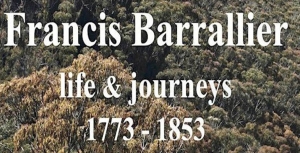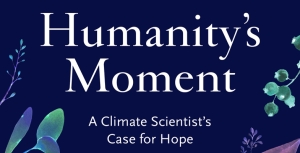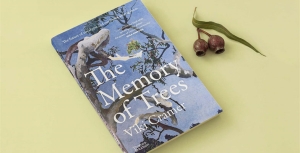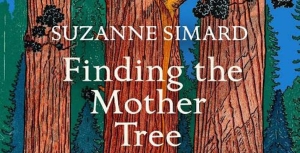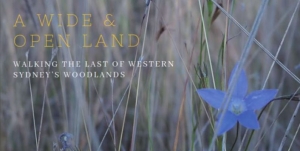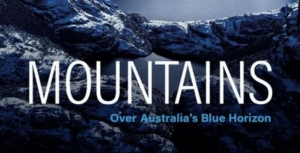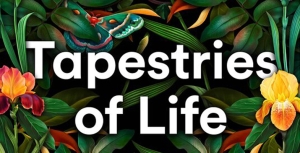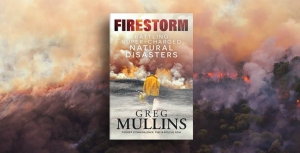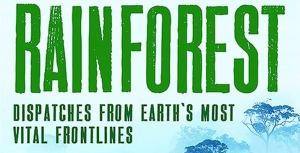Displaying items by tag: book review
The Frenchman: Francis Barrallier, Life and journeys 1773–1853
I personally got interested in the Francis Barralier story by an indirect route. I found that much of the gravels, like those at Penrith Lakes, that have flooded down across the inner Sydney Basin had been washed from a vast Devonian age volcanic formation called the Barrallier Ignimbrite of the Wollondilly Valley in a district known as Barrallier. So we visited the area via the Wombeyan Caves road and also read a version of his diary of attempts, in 1802, to penetrate and cross the Blue Mountains. All useful background, and an introduction to the challenging terrain, but this new book is currently the best source for information and the whole historic setting.
Barrallier and his party set up a depot at Nattai and made three journeys that could be termed ‘excursions’ or ‘incursions’ depending on one’s point of view. The motives were complex, stimulated by Governor Phillip King’s curiosity, and framed by the knowledge of the times, the confronting physical presence of the Blue Mountains and what lay beyond. But the concept of meeting the ‘King of the Mountains’ was also in the thoughts of the time.
The first journey in November 1802 was investigative and followed the Nattai River down to its confluence with the Wollondilly, which they crossed and made an attempt to climb Tonalli Peak, a fearsome, projecting sandstone cliff flanked by blocks and debris. They failed but shot a rock wallaby for food. They were impressed by its sense of balance and ‘mountain goat’ terrain ability – and this was possibly the first European sighting of this animal.
Barrallier's second journey, November to December 1802, was the big one. His party began by following the earlier route to the lower slopes of Tonalli, then proceeded westwards following the Tonalli River and valley past the locality now known as Yerranderie (which became a silver mining settlement). They climbed through the narrow Byrnes Gap and descended to the Kowmung River, crossing it and following tributaries Christys Creek then Wheengee Whungee Creek. This became an increasingly a tough route, rocky, and with waterfalls and ravines, and I should highlight here that they were not in typical Blue Mountains horizontal sandstone country but folded Devonian Lambie Group basement terrain of folded conglomerate, sandstone and shale – quite a different challenge. And this brought the journey to a halt at Johnston Falls. At 30 metres, this waterfall below Kanangra Walls is substantial and there’s an impressive picture in the book that indicates why it stopped them. And the option of climbing out to the Boyd Plateau was not on the table in dry, December heat. They finally gave up and turned back.
Some people have misunderstood the failure to have been due to breach of Aboriginal tribal territory but this wasn’t the case. Their relationship with the locals was mixed and eventful but had positive elements, including employing essential guides like Gogy and Boodbury. Negative aspects include cases of ‘domestic abuse’ particularly by Gogy of his female partner, and the burning of the Nattai depot huts. Botanist George Caley features in the book too through an incident in which accusations of shooting at Aborigines were aired, though not supported by the accused. Barrallier’s recorded botanic observations aren’t of great consequence.
Note: Andy Macqueen has also written a fascinating book about the history of the Grose Wilderness and the saving of the Blue Gum Forest called Back from the Brink.
Andy Macqueen (self-published) 2024,
paperback, 247 pp, RRP $40
Available from This email address is being protected from spambots. You need JavaScript enabled to view it. or Blue Mountains bookshops.Review by John Martyn
Book review: Humanity’s Moment: A Climate Scientist’s Case for Hope
Those of you who attended Ian Dunlop's STEP AGM talk on 4 November may have ended up distressed by the implications for the future from human-induced climate change, and frustrated by the slow progress of political action. As such you may not want to read any more bad news having also had more than enough from the current global scene. But I’m still strongly recommending this book, for quite a variety of reasons.
We’ve all heard of the IPCC, and maybe also read or heard the climate-sceptic’s nonsense: that it’s just a bunch of academics in ivory towers massaging dodgy data on screens to predict disasters that will probably never happen. Well Joëlle Gergis is a fully fledged climate scientist, an academic currently linked to ANU, who's a true insider on IPCC reporting, and her story is telling, compelling and very personal. In various contexts she highlights the intense scrutiny and work, often at night and into the early hours and mostly unpaid, by the thousands of scientists from all over our besieged planet. If there is any better evaluation of this ground-breaking global organisation I’ve yet to come across it.
But there’s much more to this book because it’s a personal journey by somebody who’s professional, dedicated and almost obsessive in her devotion to her science and its message. The implications of hers and the IPCC’s work have left her depressed and almost suicidal at times but she soldiers on under a worsening climate and its disasters. In this respect, the content of the book may seem repetitive at times but I never wanted to put it down. I can think of many public figures for whom it should be compulsory reading. But it does end on a hopeful note, that the means of fixing things are widely available, and work is in progress on many fronts.
Joëlle Gergis, Black Inc (2022) 325 pp (reviewed by John Martyn)
Book review: The Memory of Trees
This book was of great interest having lived in Perth for 9 years and worked and travelled at length in WA for more than 40 years, including in many areas covered in the book, set predominantly in the south-west and south of the state. It's written by freelance ecologist and writer Vicki Cramer, whose research and publications through institutes like Curtin University and the CSIRO span a wide range of WA ecology, from bats and marsupials to Western Australia’s management, exploitation and clearing of eucalypt forests. In 2021 she was awarded a Dahl Fellowship from the charitable organisation Eucalypt Australia. Though set almost entirely in WA, the book mirrors the natural vegetation situation in other states and the threats it faces.
The Memory of Trees is divided into long, quite detailed chapters dealing with topics such as Jarrah forests and their threats, the West Australian Wheatbelt and salinity, the amazing Great Western Woodlands with their vast areas of trees growing in climates so dry that trees really shouldn’t grow at all. And, of extreme importance for us in NSW, the subject of bushfire, of hazard reduction and cultural burns and their history and arguments for and against. Relevant to fire and overshadowing everything covered in the book of course is climate change, the biggest mover of the goalposts that we face.
How many plant species are native to the south-west of WA? Well, the book cites 8379 would you believe (but of course new species are discovered every year so that’s by no means the final figure). Of that number, 1750 are native to Fitzgerald River National Park for example, a big park of nearly 3,000 km2 flanking WA’s south coast, big yes, but that’s very, very rich! (Blue Mountains World Heritage with around 1500 species is three times as big). And then the Stirling Ranges: full of endemic species, some of them isolated to individual peaks. These are examples of the fragile communities surviving as large islands of natural vegetation flanked or surrounded by land cleared for agriculture? What species have been lost through the clearing process? We will never know the full number, plant or animal.
Stirling Ranges and Fitzgerald River are flanked by the WA Wheatbelt. Vast areas of forest and woodland were cleared through waves of settlement, and managed on a broadacre basis with no treed remnants allowed to remain that get in the way of the massive harvesters. Farms have merged over time and families have moved away, much as is happening in Europe. The ancient impoverished wheatbelt soils were boosted, and have to be regularly topped up with superphosphate and trace elements. Natural vegetation over most of the wheatbelt is restricted to corridors and fringes along boundaries and roadways, plus isolated small copses. Mass tree removal, their roots no longer pumping, led to gradual rise in salinity – covered by a chapter in the book that highlights the recovery efforts of landowners and community groups but also political sidestepping, ignorance and neglect. Governments like to bypass salinity, highlighting grain yields, but a brief Google search will tell you that the WA wheatbelt yields a ball park figure of around 2 tonnes of grain per hectare – Ukraine by comparison, in its heyday, achieved roughly double that.
The Jarrah forests, featuring Eucalyptus marginata, were a backbone to WA’s historic economy. The rich, deep red, termite resistant timber is hard to source today except through recycling, but it was used in building and construction, in termite proof railway sleepers and in flooring and furniture, and it was exported globally. But it grows on iron and alumina rich laterite terrain large areas of which have been mined for bauxite. Bauxite, a chemically extreme end member of a soil profile, is typically only a few metres thick and so vast areas have to be stripped and mined to yield a commercial tonnage. Companies however are obligated to stockpile and restore the surface material, and the author describes traverses with colleagues in areas ranging from pristine and even rare old growth forest to sites in various stages of restoration. But one comes away with the impression that nothing can truly replace the lost forests. And then of course there’s climate change pushing winter rainfall southwards, and Phytophthora dieback!
Now for the Great Western Woodlands: these are truly vast but exceptionally vulnerable, made up essentially of eucalypt species some of which recover from fire, like the numerous species of mallee, while others are obligate seeders and are incinerated. If you’ve travelled the wheatbelt and the southern goldfields you’ll be familiar with the copper-red trunks of salmon gums. If you’ve driven east of Norseman you’ll have seen fine examples of Great Western Woodland, and perhaps be stunned to learn that the seemingly healthy trees are growing in less than 300mm mean annual rainfall. The author's field descriptions in areas east of the wheatbelt town of Hyden are both illuminating and saddening: overall the vast woodlands are threatened by climate change, reduced rainfall, human activity and most especially by fire.
Later in the book the author veers towards positive aspects: the Gondwana Link and the Nowanup Cultural Community. Gondwana link, which involves Bush Heritage among other groups, acquires land to revegetate to eventually form a chain of natural vegetation from the coastal forests of the south-west 1000km to the east to join up with the Great Western Woodland. Nowanup on the other hand was established to rally behind and promote Noongar cultural elements of which include cultural burning, which is perhaps the only way to mitigate and soften the devastating effects of climate change and fire on the woodlands and forests within a realistic time frame.
Viki Cramer, Thames and Hudson, 2023, paperback, 292 pp (reviewed by John Martyn)
Book review: Underground Lovers: Encounters with Fungi
Prepare to appreciate the world under your feet (well, your feet grounded on the earth, maybe not on a concrete slab).
There is a network of mycelia that belong to their own kingdom: Fungus. Lacking chlorophyll, they grow from the tips of microscopic hyphae and digest nutrients externally (underground) before absorbing them into the mycelium.
One hypha is a microscopic filament but together they form a fungus mycelium (the network). Hyphae can not only branch but also fuse, or ‘anastomose’ and exchange genetic material. The cell walls are made of chitin, a hardness also found in arthropod exoskeletons. The mycelial scaffold essentially mirrors exponentially the life forms above ground. Mycelial networks bind soil particles while also aerating the soil, creating spaces in the soil. This architecture allows water to penetrate soil’s deepest horizons.
The fungi also form alliances with plants, or even digest other organisms. Fungi and algae, forming lichens, create soil on rock – as on exposed rock left by the retreating Vatnajökull ice cap in Iceland.
Many plants depend on mycorrhizal fungi – the fungi forming beneficial relations with roots: hyphae extend the roots’ absorbable surface; the tree provides sugars from photosynthesis while the mycorrhizal fungi make nitrogen and phosphorus available to the tree.
The author gives us good reason not to clear-fell, nor burn our forests in super-hot conflagrations, nor overheat the earth with global warming, nor over-fertilise and apply weedicides to our monocrops; even the high-velocity gale of the leaf-blower dislodges spores, let alone grasshoppers, beetles and frogs. It kills the fungi.
Some ‘old growth’ trees reach hundreds of years of age; but the fungi beneath them are at least as long-lived. Old forests support a greater diversity of fungi than young, or obliterated, forests.
Interesting allusions – Pouliot mentions her US Northwest rented V8 Dodge Charger not being the ideal field vehicle ‘with the clearance of an echidna’.
The ninth chapter Women as Keepers of Fungal Lure fills a gap. I searched for books on fungi and nearly all the citations are of men’s studies.
The tenth chapter Restoring Fungi is apposite given the fungus talks by Emeritus Prof Michael Gillings and Vanessa McPherson of Macquarie University. They observed that sites where works such as a drainage pipe had been laid hosted far fewer fungi than undisturbed (or merely weeded) sites. A property owner demonstrates that we need to create diversity and reduce stresses. On her property she supplied diverse organic matter of different species, size and age, and eliminated tilling, digging, excavating, heavy machinery and even hard hooves of stock.
Mistletoe contributes to restoration, providing nectar for butterflies, gliders and possums; and when it dies its leaves enrich the soil with phosphorus, nitrogen and potassium.
Lichens colonise bare earth and are part of the cryptogamic crusts essential for forming a film that reduces wind and water erosion. This crust of fungi, algae, cyanobacteria and mosses over the soil fixes carbon and nitrogen – and is destroyed by stock. The property owner, Kazuko, observes ‘We should be starting with soil crusts rather than trees when restoring ecosystems’.
Fungi have infiltrated Landcare! Officially restoring waterways, agricultural and natural areas since 1989, the movement now recognises the necessity of healthy fungi.
The author has travelled the globe and gives examples of mycophiles’ world-wide fungus hunting throughout the book. There is a species register with common and scientific names of fungi and lichens, plants and animals; a glossary, selected sources and an index. The editor might have picked up the constant misuse of ‘among’ and ‘between’. Despite the listing of 11 images, there are no photographs. Our desire for pictures and descriptions of so many intriguing species and descriptions probably needs a mini-encyclopaedia!
Alison Pouliot, NewSouth Publishing, 2023; 278pp (reviewed by Margery Street)
Book review: Finding the mother tree: Uncovering the wisdom and intelligence of the forest
It's difficult to write a simple review of this book because it works at several different levels. But first of all, it's superb. It possibly has had more personal effect than any other I've read in the past few years.
Initially a British Columbia (BC) forest service employee, Suzanne Simard's observations didn’t tally with current forestry practises and this triggered her curiosity that led to her innovative research on forests and their trees
Ultimately its publication led to the coining of the term ‘wood wide web’ as she explored the way trees exchange nutrients and information via extensive fungal threads linking root systems, between mature parent ‘mother trees’ and their saplings but also linking totally unrelated species like birch and pines.
In this she soon came up against the entrenched government ‘free to grow’ policy which invoked the clearing of land of everything that might compete with commercial timber species. However her work, including measuring the movement of carbon and nitrogen isotopes, clearly showed this is not only unnecessary and costly but often strongly deleterious. It strongly supported the conclusion that healthier more productive forests resulted from keeping natural plant and animal communities as intact as possible.
On another level this book is autobiographical, and written by someone who was raised as the child of a forestry family in the Monashee Mountains of BC (between Kamloops and Banff) who grew up close to wild, forested country and absorbed much in the ways of people and animals in her home territory. One can very much read and enjoy this well written book at that level, and feel for all her conflicts, overcoming fear of public speaking, clashes with institutional practise and established scientific beliefs, family tragedies, and her own battle with cancer.
But there's yet another level too: much of the outcome of her research accords with long held beliefs by First Nations people that forests are a living, interactive, whole systems that communicate beneath the soil in mutually supportive ways. Such beliefs submitted for publication of course would not be accepted by any scientific journal, however her meticulous and patient supportive work most definitely has been, many, many times – she's now Professor of Forest Ecology at the University of BC.
And how does all this translate to our local forests? Do blue gums liaise with and feed and support their babies? Angophoras and turpentines often grow side by side, even touching one another, so do they also fungi-talk to each other through their roots? And what is the story now with ‘free to grow’ style clear felling? When we first set up home in Perth in the 1970s, WA's karri forests were managed on a ‘mother tree’ style basis (though I don’t remember if they used that term) leaving the biggest, healthiest trees intact to propagate for the future.
Author: Suzanne Simard
Allen Lane (Penguin) paperback, 348pp
Reviewed by John Martyn
Book review: A Wide and Open Land: Walking the Last of Western Sydney’s Woodlands
As one who enjoys long bushwalks and studying nature, having walked as a ‘swaggie’ from Yuleba to Surat along the Cobb and Co coach route in 2018 and having walked 48 km in one exhausting day and night from a bogged vehicle in isolated Chesterton National Park, south west Queensland, I was very keen to grab hold of a copy of this recent book. Not only to read about Peter’s incredible walking journey but to learn about the natural history and cultural history of the huge Cumberland Plain which comprises much of western Sydney.
Living and working in Ku-ring-gai means I have become accustomed to the Hawkesbury Sandstone environs, but the fauna, flora and history of the Cumberland Plain still remains a mystery to me.
In the winter of 2019 ecologist Peter Ridgeway set out to walk 179 km across the Cumberland Plain, the region of rural land west of Sydney. Carrying his food and water and camping under the stars, he crossed one of the least-known landscapes in Australia, all within view of our largest city. I think he was as ‘game as Ned Kelly’ to undertake this venture in an area that is much under-loved for its amazing nature and today more valued as a dormitory for greater Sydney.
This well-illustrated book recounts a unique journey across a landscape few Australians will ever see. In this open country the familiar forests of Sydney’s sandstone are replaced by a fertile world of open woodlands, native grasslands and wetlands – known as the Cumberland Plain, home to some of the nation’s most unique and endangered wildlife. The Cumberland Plain is the traditional land of the Darug, Gundungurra and Dharawal peoples, and the birthplace of the first Australian colony and it is a landscape which also holds the key to our entwined and conflicted origins.
What was once a limitless tract of woodland is now being engulfed by the city to the east, in the largest construction project ever undertaken in the Southern Hemisphere – the near elimination of an ecosystem and a past community.
This book provides a detailed immersion into the history, wildlife, and culture of one of Australia’s most rapidly vanishing landscapes, and reveals how the destruction of ‘the west’ is erasing not only itself, but we are losing something central to the identity of all Australians.
Peter Ridgeway is a highly experienced biodiversity scientist and land manager for this remarkable area and his knowledge of the Cumberland Plain is fully reflected in his writings – almost a lament for the times when he grew up in the area when times were better – at least through his childhood eyes.
Peter’s book is literally a landscape memoir, nature guide and a detailed history narrative – all rolled into one amazing book. It has similarities to the late Eric Rolls history of the Pilliga A Million Wild Acres.
In addition to a very informative text, the detailed trip maps and lovely photographs add so much to the volume.
As stated by N Scott Momaday:
Once in his life a man ought to concentrate his mind upon the remembered earth, I believe. He ought to give himself up to a particular landscape in his experience, to look at it from as many angles as he can, to wonder upon it, to dwell upon it. He ought to imagine that he touches it with hands at every season and listen to the sounds that are made upon it. He ought to imagine the creatures there and all the faintest motions of the wind. He ought to recollect the glare of the moon and the colours of the dawn and dusk.
Peter Ridgeway has admirably achieved all of this in his wonderful landscape memoir. Please purchase a copy, you will not be disappointed!
Peter A. Ridgeway ($50) from the author (This email address is being protected from spambots. You need JavaScript enabled to view it.) or Nokomis (03 5774 7083 or This email address is being protected from spambots. You need JavaScript enabled to view it.)
Reviewed by Mark Schuster, Bushfire Technical Officer/Fire Ranger, Ku-ring-gai Council and NCC bushfire representative for Hunters Hill, Lane Cove, Parramatta and Ryde Bush Fire Management Committee
Book review: Mountains: Over Australia's Blue Horizon
I can't quote a price for this book because it was a gift or rather a swap. I met the author socially at a publishing friend's lunch – he received a copy of Rocks and Trees in return though I possibly got the better half of the deal!
The author Alasdair McGregor has multiple credits to his name, he is an architect, artist, writer, photographer, expeditioner and historian of Australian explorers and pioneers.
This book, Mountains, was created on request by the National Library following highly regarded previous works like Frank Hurley: A Photographer's Life and Mawson's Huts: An Antarctic Expedition Journal.
I warmed to this book because of a personal preference for ranges like the Snowies and Blue Mountains over ‘real mountains’ like the Swiss Alps. He quotes Sir Edmund Hillary's well known comment that Tasmania's Federation Peak is ‘Australia's only mountain.’ Jagged and formidable though it is only 1,224 m high, hardly on a world scale in elevation. But that isn't really the issue in our continent where ranges like the Blue Mountains and the high peaks of North Queensland were formidable barriers to early settlers and explorers whether in terms of terrain, vegetation or in getting on with the locals.
The style of description in the various chapters is broad and framed in a historical sense because to learn what it was like to traverse Australian mountain country in early settler days is a vivid introduction, and in the case of the Snowies, to follow through their history that included early cattle grazing, Von Mueller's botanical visits, gold mining, early skiing pioneers and the Snowy Mountains scheme paints a vivid picture. Though this is embellished with the sad accounts of threats to wildlife like the Bogong Moth and mountain pygmy possum, to wildfires and to the plague of wild horses. But the Snowies is a classic illustration that on our so-called flat continent we have alpine vegetation above the tree line in one corner and tropical rainforest in others. And our fractious summers bring both tropical mangos and cool climate cherries in abundance.
Some of Australia's mountain country he describes in the book I know well, like the Hamersley Ranges through years of geological fieldwork. But the chapter I probably enjoyed most was on country I don't know; the chapter on the high mountain peaks of far north-east Queensland where cloud forests with native rhododendrons are unique on our continent but threatened by climate change. And where it rains like you wouldn't believe. He also has vivid personal stories to tell from his experiences on Heard Island where he was in the first party to climb the awesome peak of Big Ben. He still regards that island as his most beautiful place.
Alasdair McGregor, NLA publishing (National Library of Australia); hardback, 268 pp
Reviewed by John Martyn
Book review: Tapestries of Life
There are many books dedicated to nature and the environment, most of them good, some very good, but this one is outstanding.
The author is a professor at the Norwegian University of Life Sciences and her previous book Extraordinary Insects made it to the Sunday Times best seller lists. Her special interests and research lie in forest ecology and in the role played by insects, fungi and other creatures in interacting with forest plants to create a natural living web. This is especially important in old growth forests whose biodiversity goes far beyond trees into the huge range of species that inhabit and live off not just the living trees but also dead, rotting wood or mouldy leaf litter. And here was a big surprise, her homeland of Norway, a timber producer, apparently has hardly any old growth forests left, most existing ones being sustained or created by managed regrowth and plantings. Lots of comments and thoughts to ponder in this topic on how we manage and respect our own old growth forests and natural world in general.
But this is far from the whole story in the book. It extends across an amazing array of animals and plants and their interactions, from Brazil nuts that require the unique orchid bee to pollinate, to fig wasps, to incredibly ‘intelligent’ slime moulds and to our own (probably extinct) gastric brooding frogs. And she goes quite a bit into the biopharmaceutical story too, from the blue blood of horseshoe crabs to a jellyfish called Turritopsis that can reverse its life cycle back to the polyp stage and can therefore technically live forever.
And a word about the style, which if it wasn't up to it could drag a book like this down into the dumps and make it heavy going however fascinating the content. Yes, she really does write well, and she acknowledges her English translator too who carries some share of the top marks for the final product.
Anne Sverdrup-Thygeson, Mudlark (Harper Collins), paperback 344 pp, $27.99
Reviewed by John Martyn
Firestorm by Greg Mullins
Between July 2003 and January 2017 Greg was Commissioner, Fire and Rescue, NSW. Being a former employee is an advantage when he speaks out publicly because public servants are not so encouraged. He is the person who organised Emergency Leaders for Climate Action (ELCA), a group of 34 past fire chiefs and experts who implored our Prime Minister to meet with them and understand the predictions for the 2019-20 fire season. Self-funded, they eventually managed a meeting with Ministers Taylor and Littleproud after some adverse media coverage.
This is an exciting adventure story of a local young man fighting fires all around Sydney’s North Shore, until chapter four. He applied for and received a Winston Churchill Memorial Trust Fellowship, as government agencies have no funds for R&D overseas travel, and observed bushfire control in England, France, Spain, Canada and the USA.
Californians do it in style! Within hours a small town would be set up: command units, catering units, shower and toilet bocks, busloads of experienced firefighting prisoners, T-shirts naming the fire for sale; and of course water-bombing aircraft and experts form Alaska, Colorado and Florida. The Oakland Fire Department had a novel prevention strategy, namely, that homeowners with a heavy fuel load could hire a ‘goat man’ to lose his herd of goats to effectively eat the fuel.
Throughout the book Mullins notes changing weather conditions in Australia and around the world. People have to accept that what worked in the past will not suffice in the hotter, drier future. Following the 1994 fires, a fire brigade station officer brought us the community fire units so familiar to us around the suburbs.
Enabling homeowners to wet down the bush, prepare their homes and emerge after the fire to put out small fires and embers, community fire units were decisive in the 2002 fires in Lane Cove in saving houses.
It is not the ‘much-derided so-called greenies who are the real canaries in the coal mine…it’s our farmers and primary producers’ [p145]. They suffer first from climate change. The account of ELCA’s attempts to meet with the Prime Minister from April 2019 made my hair stand on end. The Murdoch press personally attacked Greg Mullins and the former Queensland Fire and Emergency Services Commissioner; the federal government held back two tranches of funding until December and January when it was, of course, too late to source additional aircraft from overseas. Even then-current Commissioner of the NSW Rural Fire Service, Shane Fitzsimmons, was vocal, and noted that the PM had not warned him of unilaterally calling out army reservists to help fight the fires.
Mullins debunks the five biggest myths promulgated on social and other media destined to deflect attention from worsening climate change: in fact, Greenies never had control of decision-making on hazard reduction burning; we have not had weather conditions like this before; arsonists did not cause those fires; grazing in national parks does not reduce fuel loads - cows don’t eat many branches, twigs, bark, eucalyptus leaves and bark; we have not had worse fires before. Mullins then tells what the experts really said, basically that climate change is exacerbating fire danger.
He gives short, medium and long term directions to save ourselves. Some are as obvious as mandatory smoke alarms; cigarettes that self-extinguish in dry grass; and sprinkler systems in aged care facilities.
Unfortunately the book has no index. However, dates and names are precise; there are 109 references as well as appendices on factors affecting fires, fire dynamics, and finally, a word on how the ANZACs might view our disregard for facts.
Reviewed by Margery Street
Book Review – Rainforest: Dispatches from Earth's most Vital Frontlines
There are many books on the environment, as you will see if you scan the shelves of bookshops like Kinokuniya, Abbeys or the Botanic Gardens. Many are well written too, vividly conveying an author's enthusiasm and love of nature though usually with guarded warnings about the future. But I stumbled on one recently that's exceptional. Written by Tony Juniper, long time campaign head and rainforest guru for Friends of the Earth and currently of WWF, it covers a vast spread of information on this precious global asset.
Juniper describes and highlights the enormous diversity of flora and fauna in rainforests both tropical and temperate, of which many people are already aware of course, but what I found compelling were the insights into the negative effects of clearing of rainforest on the mistaken philosophy that rainforest stands in the way of progress. This has effects not only on diversity but also on climate. He highlights research on the cyclical relationship of transpiration and rainfall, pointing to the enormous surface area of foliage available for evaporation – far more than if the same area were covered by water. He also, alarmingly, points to increasing drought in cleared land, and in agricultural land, savanna, and semi desert up to thousands of kilometres from retreating forests. (And yet we still allow tree clearing in this drought-ridden country?)
The diversity of course includes the traditional inhabitants, dismissed as of little consequence or an obstacle by European settlers and governments, from Theodore Roosevelt's ‘tenantless wilderness’ to our very own terra nullius. The chapter on the Amazon Basin is particularly illuminating because it highlights how the original people farmed the fertile flood plains, not by wholesale clearing but by retaining the canopy trees because they protect and enhance the soil and its moisture and fertility. Rainforest crops like cocoa and coffee grow best in protected settings. Wholesale clearing to plant oil palms and soya beans however is already having alarming consequences. (I rummaged through the pantry and fridge to see if we had anything containing palm oil to chuck; and then what about soya products?)
Tony Juniper is a veteran and very effective environmental campaigner and appears to have sufficient people skills to get opposing factions onside, despite being arrested and marched off at gunpoint in Davos. This includes both big business, politicians and land managers, including indigenous ones, and there is hope for the future beginning to dawn, but a lot more progress needs to be made, and soon!
This book is a must-read for politicians and land managers, especially many of the former! Oh, and Prince Charles gets a guernsey for his forest support – a good choice for future king I think!
Rainforest: Dispatches from Earth's most Vital Frontlines by Tony Juniper, Profile Books, London, 2018, 448 pp
John Martyn reckons this is the best environmental book he has ever read!

